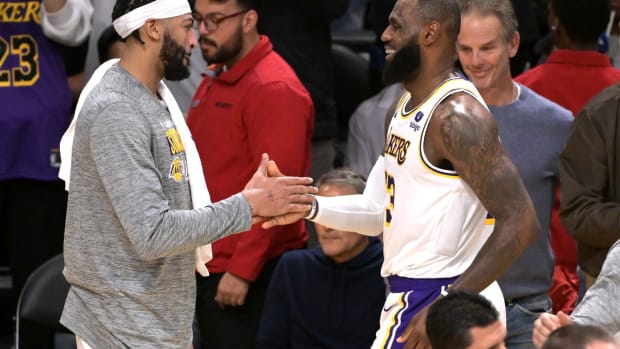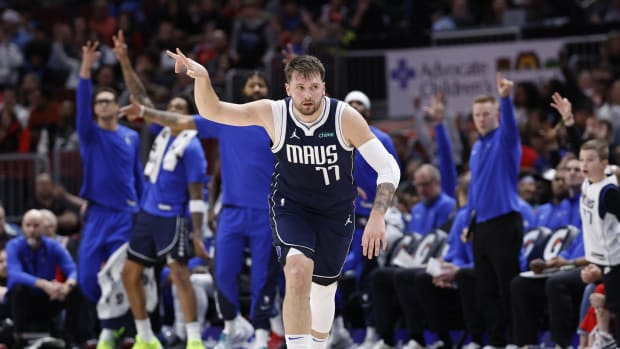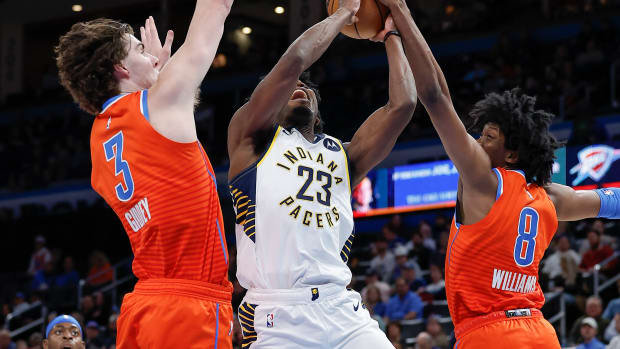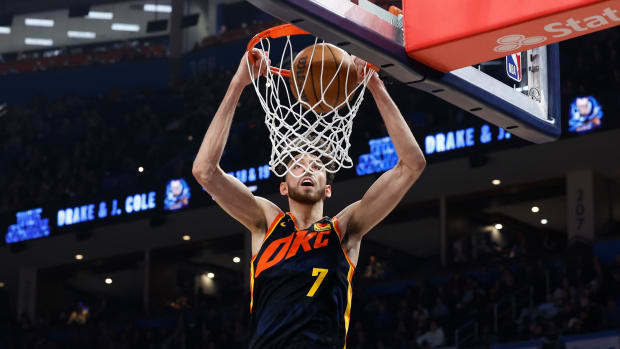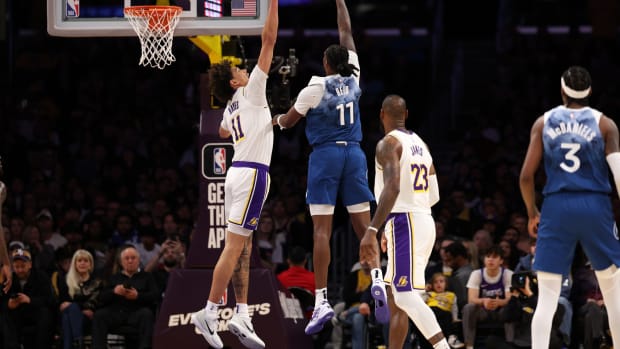Assessing Duke's Other NBA Draft Prospects After Zion Williamson's Injury
Watching from the stands as Zion Williamson hit the floor 30 seconds into Wednesday’s Duke-North Carolina game was as anxiety-inducing as you might imagine for someone who spends many of their waking hours concerned with the NBA draft. Still, from a scouting perspective, the timing of his injury (which, thankfully, was not overly serious) did create a useful window to evaluate the Blue Devils’ other prospects in his absence. With R.J. Barrett and Cam Reddish likely to hear their names called early on draft night and Tre Jones projected in the mix later in the first round, it’s been helpful to watch all three operate without Williamson, who is as impactful as any player in college basketball and the primary catalyst for Duke’s success on both ends of the floor.
After Williamson’s knee sprain abetted what became a somewhat excusable loss to Carolina, Duke took 48 hours to prepare and bounced back on Saturday night at Syracuse, led by 30 points from Barrett. While it’s unclear how much longer Williamson will be out, the two-game sample with him off the floor did shed some additional light on Duke’s individual strengths and weaknesses. Let’s take the opportunity to re-assess.
R.J. Barrett
Totaling 63 points while logging every minute of the last two games, Barrett’s recent play has reinforced what we’ve come to understand about his game. He’s an aggressive, effective downhill player with the agility to navigate tight spaces and create looks for himself around the basket. Barrett leads Duke and the ACC in scoring despite a streaky three-point shot, and has really come into his own as a passer over the past month, which is a critical development. He’s also done well impacting the game on the glass and helping Duke get into transition, where his strength and ability to finish with his left hand shine.
Absent Williamson, some of the concerns with Barrett’s off-dribble creativity come to the fore. He’s more of a one-cut player going into the paint, and more reliant on playing bully ball with his size and strength than truly breaking opponents down. Right now, he’s not especially comfortable using his off hand and tends to drive into contact rather than finish around or over opponents’ length. Those issues are exacerbated when he attacks set defenses, and his jump shot isn’t quite at a point where defenders should be incentivized to run him off the line. Defensively, his tendencies have been underwhelming. Still, Barrett is in terrific shape, consistently plays with great effort (at least on offense) and is not afraid of making mistakes, all of which help mask some of his weaknesses at the college level.
With the knowledge that Barrett at his core is an alpha scorer, and that even the best NBA players tend to revert to their long-held tendencies in pressure situations, the big question projecting forward is whether a fully-realized version of what he is now is a player you can run a winning, efficient offense through. His evolution as a playmaker is promising, and the more willing he is to share the ball the closer he’ll come to realizing his potential, but Barrett is still chiefly a ball-dominant player with a shaky outside shot, two factors that aren’t generally simpatico in the pros. Even playing next to Williamson, there have been key situations where it seems markedly obvious that Barrett’s intention is to score, and the recurring tunnel vision is a concern. He won’t be able to push around better-equipped defenders who can match him athletically, and it’s imperative his craft as a scorer improve to where it can compensate for his lack of improvisational ability off the bounce.
Adjusting to the pace and physicality of NBA play will be the biggest challenge he’s faced to date, and ideally, Barrett ends up in a situation where he can develop as a supporting option, rather than feel the whole weight of a franchise as a rookie. His status as a projected top-three pick remains safe, particularly as many of the other lottery-caliber prospects have struggled to establish themselves on a consistent basis. He’s been productive and done what’s asked of him, and Duke has needed every point. Barrett’s strong 30-point game without Williamson against Syracuse (and a triple double last weekend against NC State) have his arrow trending in the right direction going into March. But from an NBA lens, in terms of pure talent, Williamson is well ahead, and it has never been extremely close.
Cam Reddish
At this point, it’s probably time to reframe the long-term expectations for Reddish, who remains as mercurial a prospect as there is in college basketball. Coming up through high school, there was some thought he’d have a chance to be a star, but his well-formed habit of blending into games has tempered his perceived ceiling among some scouts. The general thought was that without Williamson, Reddish would have a strong opportunity to step up and make his case (as he did against Florida State in January when Williamson was poked in the eye). But even when putting up big numbers, he’s been something short of convincing.
Reddish was again a mixed bag in the loss to North Carolina, with 27 points on 23 attempts, zero assists and four turnovers in a game Duke lost by 16. While he made a few impressive jumpers that highlighted his NBA potential as a perimeter scorer, it’s his ongoing struggles scoring in the paint that have become something of a yellow flag. Reddish, who up until this point in his career was able to rely on his size and outstanding basketball build around the basket, lacks a level of ingenuity as a finisher and has had recurring problems when driving into the paint against bigger defenders. In transition and man-advantage situations, his passing ability and smoothness are often enough, but right now there’s a missing element, and Reddish isn’t getting to the foul line enough to augment those struggles.
Making matters worse is how unpredictable he’s been night to night. Reddish played all 40 minutes in the win over Syracuse, but finished with just five points on 2-of-11 shooting, making just one of eight three-point attempts against the Orange’s zone defense and never once going to the foul line. While he is more than capable of getting hot from outside and swinging a game, it’s begun to feel like he’s launching threes simply to compensate for his struggles to create good shots otherwise. On the season, Reddish is shooting 39.8% on 118 two-point shots, and 33.2% on 208 three-pointers. The disparity in attempts is due in part to the ball-dominant Barrett and hyper-efficient Williamson, but it’s simply not the profile of a player who should ever be counted on to shoulder an offense. Sure, Reddish was used to having the ball more in high school, but based on what he’s done when he does have it (and his struggles to adjust), it seems more likely his ceiling is that of a very good role player.
What will work in Reddish’s favor is that in this draft, profiling as a useful third or fourth-best player at the NBA level is still going to earn him an early selection. When he has it going, he still very much looks the part. His ranginess on defense and potential to defend bigger wings, smaller bigs and some guards are going to be endearing, and if a team can help him find a level of consistency on offense, Reddish could conceivably become a Nicolas Batum-type contributor who is effective alongside better players. The chance (however slim) he could end up something more than that will help his case, as well.
Tre Jones
Somewhere along the way, individual expectations for Jones became a bit inflated but he continues to be a critical tone-setter for Duke with his tenacious defense, quick hands and strong instincts guarding the ball. Against North Carolina, he was extremely effective bottling up the bigger Coby White, another freshman who is generally seen as a first-round talent. Jones’s leadership, effort and overall intangibles are rock-solid, and he’s done a good job understanding his role and getting the ball where it needs to go. He regularly makes good passes and decisions, and won’t have a problem accepting and settling into a role down the line.
While Jones deserves plenty of credit and has been one of the more impactful perimeter defenders in college basketball, he’s still not overwhelmingly physical, and his basketball IQ, timing and foot speed will all level off as the level of competition raises in the pros. He has enough size and toughness to think he can be impactful, but labeling him a future All-Defense selection would probably be jumping the gun. As a player who is generally seen by teams as a game-managing guard long-term, Jones’s defense might need to be truly elite for him to become a full-time starter on a good team, and that shouldn’t be considered a foregone conclusion.
Still, in a draft that’s thin at point guard, Jones certainly warrants consideration in the late first round—he has enough going for him in enough areas to leave Duke this season and end up in a good situation. The most serious concern that could inhibit Jones from sticking around long-term is his three-point shooting, which has been alarmingly inconsistent. Noting the NBA’s premium on shooting and spacing, if Jones can be left alone on the outside, it could wind up being a dealbreaker. After multiple in-person viewings, it appears he doesn’t shoot the ball with consistent rotation or confidence from distance.
Zion Williamson
Perhaps the most affirming aspect of Duke’s entire past week is just how substantial an impact Williamson has made, and how directly he impacts his team and augments winning. In addition to watching Duke struggle against UNC without him Wednesday, the Front Office was in attendance as Williamson and the Blue Devils bowled over NC State four days prior. When he’s off the floor, Duke lacks a pronounced physical advantage against the opposition, doesn’t run as effectively or as often in the open floor and lacks a safety valve when it comes to creating high-percentage shots. His absence as a help defender was also massively felt—UNC’s Luke Maye, who is generously listed at 6’8”, had his way with Duke and was free to roam the baseline along with Cameron Johnson.
All at once, Williamson is Duke’s best shot-creator, finisher, athlete, rim protector and, above all else, its most consistent performer. Despite his flaws, he is an engine for winning basketball in every sense, and will have a chance to impact an NBA team in a similar fashion due to his otherworldly physical gifts: he will reach the league as perhaps its most impressive specimen off the bat. If there was any doubt remaining that he should be the first player drafted, understanding the gaping hole he creates while sitting on the bench should erase it.
































